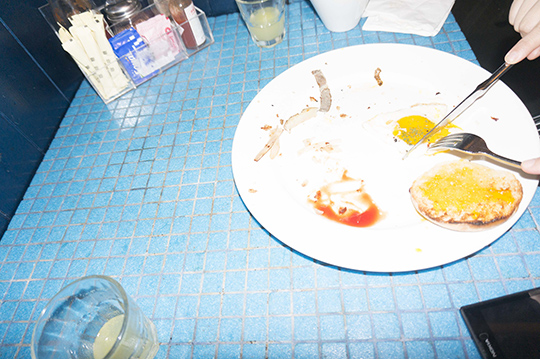780s
| March 24, 2015 | Post In LEAP 31
TEXT / Wu Mo
Translated / Vanessa Nolan
BLINDSPOT GALLERY, HONG KONG
2014.11.15~2015.01.10

Taking on the explicit aim of promoting contemporary photography, as Blindspot Gallery does, implies a sense of crisis. As the gallery notes in its mission statement, photography has disappeared into a blind spot, becoming a neglected medium. This awareness of crisis runs through the gallery’s latest exhibition, “780s.” As the name suggests, this is an exhibition of photography and mixed media by seven Hong Kong artists born in the 1980s, showing how these artists think of and use photography as a medium in “a digital era overflowing with images.”
Walter Benjamin laments, in his “Little History of Photography,” that “photography will assume from painting the mantle of conveying tradition”; times change, and photography is now feeling the challenges of a medium reinventing itself. We might think of these seven artists’ choice of photography as a creative medium as the ongoing exploration of photography as a subject. If Roland Barthes considers photography’s essence to lie in its closeness to the reality of things, today it might be better described as a reality that is not what it seems, as in Eason Tsang Ka Wai’s Floral Fabric. Only up close does the viewer realize that what looks like mass-produced multicolored floral fabric is, in fact, made up of blossoms laid out in a pattern on the ground. Under the camera lens they are stripped of their three-dimensional nature; the composition, with petal-patterned canvas shoes placed to one side, contributes to a deliberately two-dimensional effect. The same optical illusion appears in Lai Lon Hin’s “Lean Against the Wall” series. The artist uses an ordinary mobile phone to take a large number of low-resolution photographs; the resulting loss of detail leads to a dulling of the senses and leaves the viewer unable to see the facial features of the people in the photographs—they turn out to be close-up shots of posters.

Because smartphones have become ubiquitous, the line between photographer and artist has become unclear. And when photography and the internet come together, it is hard to separate private and public lives. Cheung Wai Lok’s work takes an active approach to this subject: he transfers photographs in which he has been tagged by friends on Facebook onto silver gelatin photographic paper, using traditional techniques to expose and develop them into selfies that look like black-and-white negatives. Doreen Cheung and Trevor Yeung put their intimate lives openly on display: Cheung’s 27.0 consists of images of parts of her own body along with discomfiting objects and details from her own life, as if inviting an audience into her personal life; Yeung’s Sleepy Bed is a series of sleeping strangers with whom he has shared a room in hostels around the world. In photographing people in this way, Yeung creates a relationship with them, and, by etching abstract patterns into the glass of the frames following the curves of their bodies, he strokes his anonymous roommates and caresses his imagined lovers.
For others, photography can be combined with other media without losing its impact. Siu Wai Hang’s Inside Outland incorporates still photography and video, shooting mainland China from the border with Hong Kong in order to convey the surviving memories of his father’s generation. South Ho Siu Nam’s Defense and Resistance records a performance piece: he piles bricks stamped “MADE IN XIANGGANG” into a loose perimeter and barricades himself inside, an obvious reference to the city’s current situation. Almost by accident, Ho’s work reveals the motivation behind this exhibition—a state of deep anxiety about the predicted decline of traditional photography and an attempt to recreate its boundaries. But, as Benjamin points out, discourses of photography are often confined to photography-as-art and rarely concern themselves with art-as-photography, a topic of greater social significance. Following Benjamin, if we step outside the borders of art and consider photography in cultural history, there is a possibility for a broader solution.
Wu Mo (Translated by Vanessa Nolan)

